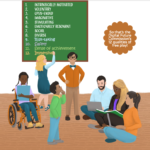The range of what we think and do is limited by what we fail to notice. And because we fail to notice that we fail to notice, there is little we can do to change, until we notice how failing to notice shapes our thoughts and deeds.
—R. D. Laing, 1990
I’m noticing in my own life that I don’t have enough time for reflection. I’m talking about a very purposeful type of reflection…I call these purposeful, scheduled “time-withins” Learning Conversations (after the work of a few of my mentors who did breakthrough work in meta-learning or learning how to learn).
What happens when I don’t create the time to reflect? Stress levels go up, worry takes the lead, will power goes out the window, and I’m looking for any old escape button to relieve the pressure (think Facebook scrolling, think media consumption, think ADHD on steroids). Can you relate? Do you think your kids appreciate the need for reflection? Where do they learn that today? When and how do they see you reflecting?
I’ll share a few insights with you…
Reflection is a necessary practice to support mindful digital life. Twenty minutes of scheduled reflective time is better than zero minutes. In my experience, if I don’t put it on my calendar, it doesn’t happen. Take a look at your calendar for the next few weeks. Block out a little “time-within” for yourself next week and the week after. I hear you thinking, It’s Thanksgiving week! Yep. All the more important to schedule some reflective time for yourself in advance.
Ideally, step away from your laptop and your phone or put your phone in airplane mode. Let people who need to reach you know you have a meeting during that time and will be unavailable (you don’t answer the phone or texts in a meeting with your work colleague or client, do you? Treat this meeting with yourself with equal importance and appropriate protocol).
Dedicate a paper notebook for these Mindful Digital Life reflective conversations and bring a pen. Find somewhere you won’t be distracted by anyone for at least 20 minutes. Here are a few prompts for your conversation with yourself to get you going.
- What do I appreciate the most about having a mobile phone?
- If I could change one thing about how I am using my phone, what would it be?
- What is my child (children/tweens/teenagers/young adults) learning from me about digital life?
- What would they want me to do differently?
Schedule, show up, enjoy the process. Be patient with yourself. Building a new practice takes time. The following week, reread what you wrote in week 1. Then ask yourself: how can I make this Mindful Digital Life “time-within” a regular weekly practice?
#MindfullySocial
I like the current challenge going around on Facebook: “Seven days of black and white photos of everyday life. No people. No explanation. Be creative, challenge a friend.” It invites us to step out of consumer-mode and into creator-mode. Here is my Day 0 in response to a challenge to participate from one of my friends. I called it Day 0 because technically, it’s not black and white. But I shot this photo a few weeks ago because the scene—one of my favorite spots on the California coast—struck me as grey scale on that particular day.

Next up…
I’ll go into more depth on the practice of Learning Conversations next week. And as promised last week, I’ll write about the new routines I design to support my own mindful re-engagement with news. I’ll offer specific suggestions about moving beyond the “fake news” meme to a more nuanced understanding of the forces at play today in the media ecology, and I’ll point to a range of resources to help our kids get savvy about news.


